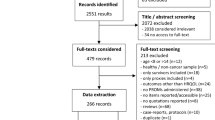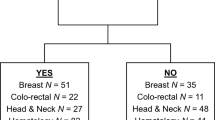Abstract
This study examined the reliability and validity of the Health Utilities Index (HUI) Mark 2 system, a health-related quality of life (QoL) instrument, in children with cancer. The sample consisted of 61 mothers of paediatric oncology patients, aged 4.1–17.3 years, who were either on treatment (n = 20) or off treatment (n = 41). The test-retest reliability was very good for the HUI Mark 2 system global score and all of its dimensions except pain. The HUI Mark 2 dimensions of emotion, pain and self-care as well as its overall score showed moderate convergent validity with other measures. In addition, the HUI Mark 2 system demonstrated good discriminant validity. However, the content validity of the HUI Mark 2 system when considered as a multiattribute descriptive health profile is questionable because it fails to assess domains such as neuropsychological and psychosocial functioning. Overall, the results indicate that the HUI Mark 2 system is reliable and valid as a measure of health-related QoL for paediatric oncology patients.
Similar content being viewed by others
References
Bradlyn AS, Harris CV, Warner JE, Ritchey AK, Zaboy K. An investigation of the validity of the quality of well-being scale with paediatric oncology patients. Health Psychol 1993; 12(3): 246-250.
Koocher GP. Surviving childhood cancer: issues in living. In: Spinetta JJ, Deasy-Spinetta P, eds. Living with Childhood Cancer. St Louis, MO: The C.V. Mosby Company, 1981: 171-183.
Ekert H. Childhood Cancer: Understanding and Coping. Philadelphia, PA: Gordon & Breach Sciences Publishers 1989.
Adams DW, Deveau EJ. Coping with Childhood Cancer: Where do we go from here? Hamilton, Ontario: Kinbridge Publications, 1988.
Mulhern RK, Ochs J, Armstrong FD et al. Assessment of quality of life among paediatric patients with cancer. Psychol Assess: J Consult Clin Psychol 1989; 1(2): 130-138.
Gamis AS, Nesbit ME. Neuropsychologic (cognitive) disabilities in long-term survivors of childhood of cancer. Paediatrician 1991; 18: 11-19.
Peckham VC. Educational deficits in survivors of childhood cancer. Paediatrician 1991; 18: 25-31.
Von der Weid N, Beck D. Séquelles tardives d'un groupe d'enfants et d'adolescents traités pour cancer entre 1981 et 1986 en Suisse. Schweiz Med Wochenschr 1993; 123(25): 1293-1299.
Anderson V, Smibert E, Ekert H, Godber T. Intellectual, educational and behavioural sequelae after cranial irradiation and chemotherapy. Arch of Dis Childhood 1994; 70: 476-483.
Jenney MEM, Kane RL, Lurie N. Developing a measure of health outcomes in survivors of childhood cancer: a review of the issues. Med Paediatr Oncol 1995; 24: 145-153.
Mackworth N, Fobair P, Prados MD. Quality of life self-reports from 200 brain tumour patients: comparisons with Karnofsky performance scores. J Neuro-Oncol 1992; 14: 243-253.
Cella DF, Tulsky DS. Quality of life in cancer: definition, purpose and method of measurement. Cancer Invest 1993; 11(3): 327-336.
Hinds PS. Quality of life in children and adolescents with cancer. Sem Oncol Nursing 1990; 6(4): 285-291.
Boggs SR, Graham-Pole J, Miller EM. Life-threatening illness and invasive treatment: the future of quality of life assessment and research in paediatric oncology. In: Johnson JH, Johnson SB, eds. Advances in Child Health Psychology. Gainesville, FL: University of Florida Press, 1991: 353-361.
Trudel JG, Dobkin PL, Rivard M, Robaey P. Psychometric properties of the Health Utilities Index with paediatric oncology patients. Qual Life Res 1995; 4(5): 496-497.
Lansky SB, List MA, Lansky LL, Ritter-Sterr C, Miller DR. The measurement of performance in childhood cancer patients. Cancer 1987; 60: 1651-1656.
Mulhern RK, Fairclough DL, Friedman AG, Leigh LD. Play Performance Scale as an index of quality of life of childhood with cancer. Psychol Assess: J Consult Clin Psychol 1990; 2(2): 149-155.
Kaplan RM, Anderson JP. The general health policy model: an integrated approach. In: Spilker B, ed. Quality of Life Assessments in Clinical Trials. New York, NY: Raven Press, 1990: 131-149.
Eiser C, Havermans T, Craft A, Kernahan J. Development of a measure to assess the perceived illness experience after treatment for cancer. Arch Dis Childhood 1995; 72: 302-307.
Goodwin DAJ, Boggs SR, Graham-Pole J. Development and validation of the paediatric oncology quality of life scale. Psychol Assess 1994; 6(4): 321-328.
Feeny D, Furlong W, Barr RD, Torrance GW, Rosenbaum P, Weitzman S. A comprehensive multiattribute system for classifying the health status of survivors of childhood cancer. J Clin Oncol 1992; 10(6): 923-928.
Barr RD, Pai MK, R, Weitzman S et al. A multi-attribute approach to health status measurement and clinical management-illustrated by an application to brain tumours in childhood. Int J Oncol 1994; 4: 639-648.
Barr RD, Furlong W, Dawson S et al. An assessment of global health status in survivors of acute lymphoblastic leukaemia in childhood. Am J Paediatr Hematol/ Oncol 1993; 15(4): 284-290.
Barr RD, Feeny D, Furlong W, Weitzman S, Torrance GW. A preference-based approach to health-related quality of life for children with cancer. Int J Paediatr Hematol/Oncol 1995; 2: 305-315.
Feeny D, Leiper A, Barr RD et al. The comprehensive assessment of health status in survivors of childhood cancer: application to high-risk acute lymphoblastic leukaemia. Br J Cancer 1993; 67: 1047-1052.
Santé Canada. Mon Combat pour la Vie: Le Cancer chez les Enfants et les Adolescents. Ottawa: Approvisionnements et Services Canada, 1996.
Achenbach TM. Manual for the Child Behavior Checklist/4–18 and 1991 profile. Burlington, VT: University of Vermont Department of Psychiatry, 1991.
Lorr M, NcNair D. Profile of Mood States: Bi-polar Form (POMS-B1). San Diego, CA: Educational and Industrial Testing Service, 1982.
Achenbach TM. Manual for the Teacher's Report Form and 1991 Profile. Burlington VT: University of Vermont Department of Psychiatry, 1991.
Torrance GW, Furlong W, Feeny D, Boyle M. Multi-attribute preference functions: Health Utilities Index. PharmacoEconomics 1995; 7(6): 503-520.
Hauser ST. The study of families and chronic illness: ways of coping and interacting. In: Brody GH, Siegel IE, eds. Methods of Family Research: Biographies of Research Projects: Vol. 2. Clinical Populations. Hillsdale, NJ: Lawrence Erlbaum Associates, 1990: 59-86.
Boyle MH, Furlong W, Feeny D, Torrance GW, Hatcher J. Reliability of the Health Utilities Index-Mark III used in the 1991 cycle 6 Canadian General Social Survey health questionnaire. Qual Life Res 1995; 4(3): 249-257.
Landis JR, Koch GG. The measurement of observer agreement for categorical data. Biometrics 1977; 33: 159-174.
Chang P-N. Psychosocial needs of long-term childhood cancer survivors: a review of literature. Paediatrician 1991; 18: 20-24.
Sanger MS, Copeland DR, Davidson ER. Psychosocial adjustment among paediatric cancer patients: a multidimensional assessment. J Paediatr Psychol 1991; 16(4): 463-474.
Sprangers MAG, Aaronson NK. The role of health care providers and significant others in evaluating the quality of life of patients with chronic disease: a review. J Clin Epidemiol 1992; 45(7): 743-760.
Torrance GW. Utility approach to measuring health-related quality of life. J Chronic Dis 1987; 40(6): 593-600.
Feeny D, Furlong W, Boyle M. Torrance GW. Multi-attribute health status classification systems: Health Utilities Index. PharmacoEconomics 1995; 7(6): 490-502.
Cassidy J. Child-Mother attachment and the self in six-year-olds. Child Devel 1988; 59: 121-134.
Author information
Authors and Affiliations
Rights and permissions
About this article
Cite this article
Trudel, J.G., Rivard, M., Dobkin, P.L. et al. Psychometric properties of the Health Utilities Index Mark 2 system in paediatric oncology patients. Qual Life Res 7, 421–432 (1998). https://doi.org/10.1023/A:1008857920624
Issue Date:
DOI: https://doi.org/10.1023/A:1008857920624




